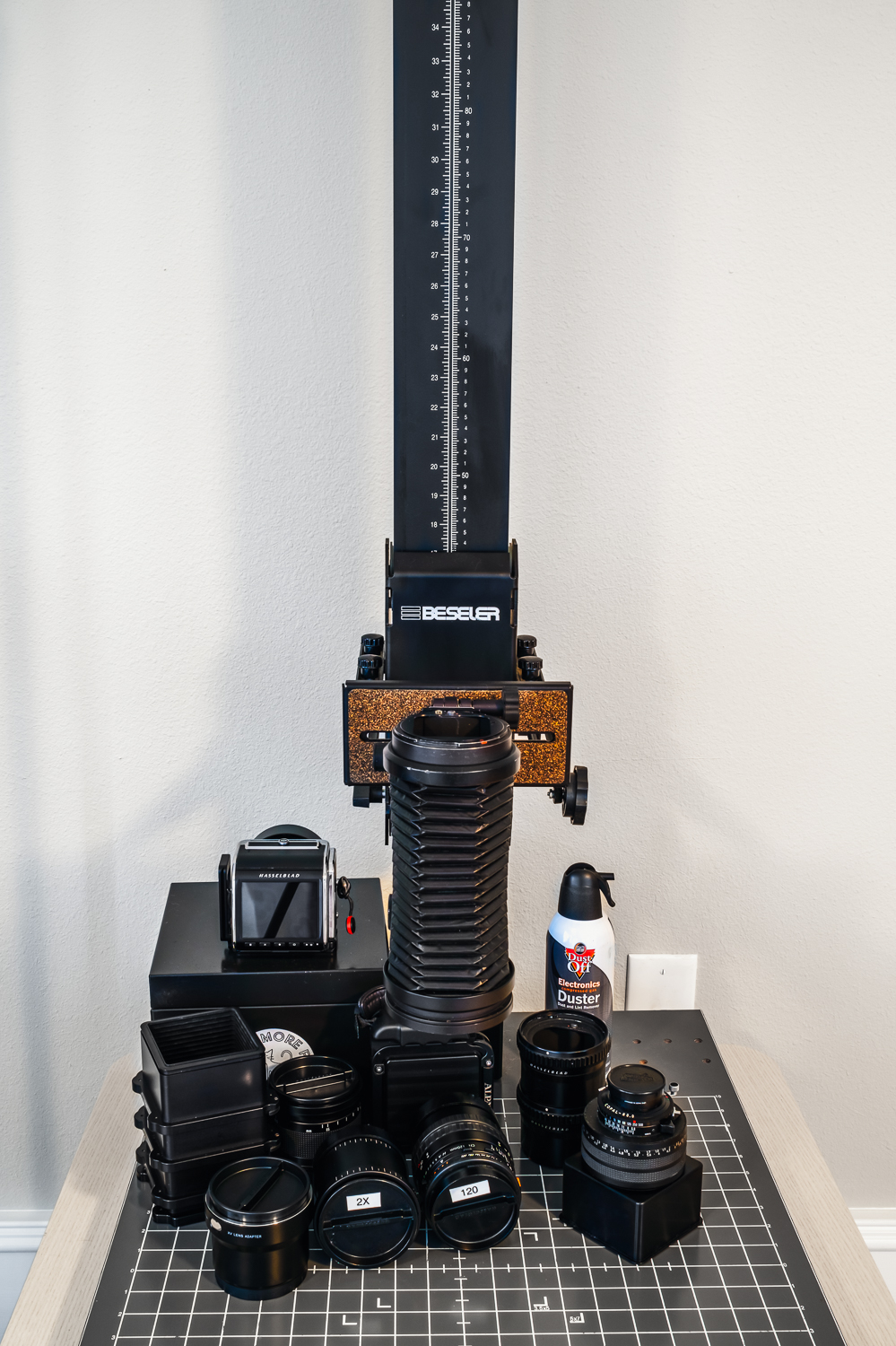In my experience digitizing film with the Hasselblad CFV 50c and CFV II 50c digital backs, I've explored various combinations within the Hasselblad V system, including using the Flexbody. I've worked with the CFi 120mm M, CF 135mm M, multiple extension tubes (including the variable extension tube), a 2x teleconverter, and bellows. Additionally, I've used the ALPA TC paired with multi-use adapters to achieve 240mm of extension, combining these with a Schneider Digitar 120mm M lens and the same digital backs.
While the results from the Hasselblad V system were quite good, I found that the digitizing workflow was smoother with the ALPA setup. Although this setup isn't the ideal workflow for me, it does improve upon using only Hasselblad equipment. Let me explain.
For my digitization process, I mount everything on a Besler CS-21, a copy stand designed for medium and large format cameras. My approach includes both stitched copies and single-frame shots, often using bracketed exposures to see if this technique benefits the negatives. In some cases, the bracketing proved to be valuable. Through this process, I discovered that similar results could be achieved using smaller format sensors, like APS-C.
Today, I no longer rely on a medium format digital back for film digitization. However, I still use my CFV II 50c digital back with an ALPA camera and lenses for small product and still-life photography, utilizing the copy stand as needed.
You might be wondering why I haven't used the 907x body for digitizing. The main issue with this setup is the strain it can place on the camera's lens mount when mounted on a copy stand. Without additional support—such as a foot on the lens or bellows—the weight can stress the camera's lens connection point. To avoid this, I would rely on the bellows, which have a built-in foot, but nope, I am not going that route again; as I said prior, building out the system based around the Hasselblad bellows and tubes is too clunky for my workflow needs.
If you plan on using the 907x with the XV adapter and 120mm M or other lenses and extensions, I strongly recommend adding a lens foot to help distribute the weight. When I first tried mounting everything with the CFi 120mm M, it felt like I was taking a chance on the safety of my gear, which did not align with how I liked to manage my equipment or spend my shooting time. For those considering this configuration, I suggest following Hasselblad 503cw's example by using tripods. However, depending on the film formats you intend to digitize, tripods might not work for all setups, which is why a copy stand is an option.
Nowadays, I've simplified my digitizing process by using a Fujifilm X-Pro3 paired with a Zeiss Touit macro lens. This lens handles autofocus effortlessly and fills the frame without needing additional tubes or bellows. If I need larger image files, I capture slices that can be easily stitched together in Lightroom.
For lighting, I rely on a Sunray Copy Box II for 6x6, 6x12, and 4x5 negatives. For my 6x17 negatives, I use an old Microtek negative carrier placed on a Kaiser lightbox.
Below is a snapshot of most of the gear I've used for digitizing film. However, my go-to setup remains the X-Pro3 with the Zeiss Touit 50mm M lens on autofocus. If film digitizing were something I did more frequently, I'd consider investing in a high-resolution camera, like a 60MP Sony with a dedicated macro lens.
Everyone has unique needs when it comes to digitizing. For my process, I've found that using digital backs isn't necessary. If I were offering digitizing services for consumers or businesses or selling large wall prints (I do not sell prints), I'm sure my equipment choices would be different. But for my current photography needs, I'm pretty content using my copy stand with a lightweight camera and an excellent macro lens that delivers precisely what I need through autofocus.
Best to you,
Darr



